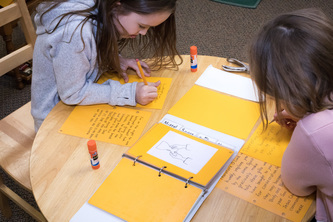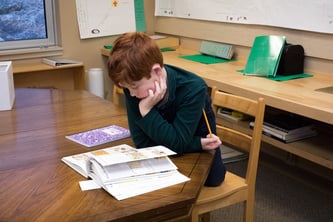CGS Frequently Asked Questions
-
-
"I am the Good Shepherd, I know mine and mine know me." John: 10
What will my child learn in Catechesis of the Good Shepherd?
Catechesis of the Good Shepherd (CGS) offers children a peaceful, sacred space to grow in their relationship with God. Each session takes place in a specially prepared environment called the atrium—a calm and inviting room designed to support prayer, reflection, and discovery.In the atrium, children are encouraged to move slowly, speak quietly, and listen for the voice of Jesus in their hearts. They work at their own pace, engaging with hands-on materials that help them explore key elements of our Catholic faith—such as the Kingdom of God, the Sacraments, the life of Jesus, and more. Through Scripture, song, and silence, children’s prayer life is gently nurtured.
More than just learning about the faith, children come to fall in love with God. CGS is founded on the belief that each child already has a relationship with God, and our role is to help them deepen it. Each week, your child will experience presentations based on the Bible and the liturgy, leading naturally into moments of quiet study, reflection, and prayer.
The materials used in CGS have been developed and refined over the past 50+ years to meet the developmental needs of children. Based on the Montessori method, this approach supports the whole child—body, mind, and spirit—and encourages self-directed, meaningful engagement. Each group receives guidance from a trained adult catechist, who presents core themes from Scripture and liturgy. Afterward, children are invited to choose and work with materials that help them reflect and respond to God’s love in their own personal way.
Children participate in age-appropriate levels:
Level I: Ages 3–6
Level II: Ages 6–9
Level III: Ages 9–12
Journey Continues: Ages 12–14.
Holy Trinity also offers a Sacramental Preparation Program to prepare children and their parents to receive their First Reconciliation and First Eucharist sacraments.
What happens in the Level I atrium?Level I begins with an introduction to the atrium—a sacred, peaceful space thoughtfully prepared for the children. In these early weeks, we guide them in how to move and speak with care, how to handle materials respectfully, and how to show kindness to one another within this special environment.
The year opens with practical life activities such as pouring water, sweeping, and arranging flowers. These simple, hands-on tasks capture the children’s attention and help them develop coordination, concentration, and reverence for their surroundings. As they repeat these exercises, they grow in self-control—quietly preparing their hearts for moments of stillness, reflection, and prayer.
Our presentations follow the rhythm of the Church’s liturgical year. During Advent, we share the stories of Jesus’ birth; in Lent, we reflect on the Last Supper; and in the Easter season, we contemplate the Empty Tomb. Other presentations for children ages 3–6 include the sacred vessels and gestures of the Mass, the geography of the Holy Land, and the signs and symbols of Baptism.
At the heart of this level is the Parable of the Good Shepherd, which speaks deeply to the young child’s soul. Sofia Cavalletti and Gianna Gobbi found that children are especially drawn to this image of Jesus—the Shepherd who knows each one by name and loves them completely. This parable is shared often, inviting the children to rest in the quiet joy of being known and loved by God.
What happens in the Level II atrium?
Level II builds upon the foundations laid in Level I, revisiting many of the same materials but with added depth and detail appropriate for the child’s growing understanding.
A key focus in this level is the unfolding of Salvation History—the story of God’s loving plan for humanity—and the unique role each of us plays within it. Children also begin to explore the structure and content of the Bible: how it came to be, the names of its books, and how to navigate Scripture through chapter and verse.
As children prepare for First Reconciliation and First Communion, they are introduced to parables that speak to the themes of forgiveness, grace, and communion with God. Among these, the Parable of the True Vine (John 15:1–11) is especially meaningful. Sofia Cavalletti and Gianna Gobbi found this image deeply resonates with children at this stage, as they begin to understand their connection to Christ and to one another.
Moral formation is also a central theme in Level II. Children reflect on moral parables and the Maxims—short sayings of Jesus that guide us in how to live in right relationship with God, with ourselves, and with others. The prayers and gestures of the Mass are revisited and synthesized, helping the children connect the liturgy with their own interior life.
Throughout, we reflect on the gifts God gives us and how we can respond with love and service, working together to help build the Kingdom of God.
"I am the vine, you are the branches; remain in me."
— John 15What happens in the Level III atrium?
Level III invites children into a deeper exploration of Salvation History, focusing on the story of the People of God and their journey throughout time. A key component is the timeline of the Jewish People, which helps children understand the unfolding of God’s plan and how it leads to the coming of Christ.
In this level, children study the Sacraments in greater depth and explore the full structure and meaning of the Mass, including its prayers and gestures. They are introduced to typology, a way of reflecting on Old Testament events—such as Creation, the Fall, the Flood, and the lives of Abraham and Moses—as prefigurations of Christ and His saving work.
Children also receive meditations on Reconciliation, the moral life, and the prophets, encouraging them to reflect on their own relationship with God and their call to live with integrity and purpose.
A central theme in Level III is Parousia—the promised return of Christ when “God will be all in all.” Children at this age, often described as “children of hope,” are filled with longing and anticipation. They are eager to welcome Jesus and actively seek ways to help prepare the world for His coming.
What happens in Journey Continues?
Journey Continues is designed as a natural extension of Catechesis of the Good Shepherd for adolescents, ideally welcoming students as they move directly from Level III into this next stage of formation. Like Level II’s approach to sacrament preparation, participation is flexible—your child is welcome to join at any point during the 2–3 year program, regardless of when they receive the Sacrament of Confirmation.
This program is built on four core pillars:
Scripture
Service
Experiential Skills
Sacramental Living
Together, we journey with your child through each of these areas, nurturing a deeper, more mature faith that is rooted in relationship with Christ and expressed in daily life. Whether or not your child has received Confirmation, they are invited to grow spiritually and personally alongside their peers.
A central emphasis of Journey Continues is living out our faith through active service to the Church and community, encouraging adolescents to become engaged, compassionate disciples.
What is the Sacramental Preparation program?
The Sacramental Prep Program helps children and their parents prepare for First Reconciliation and First Eucharist. This program offers the same quiet, meditative atmosphere experienced in the Atrium. Preparation takes the place of other parish sacrament preparations for those who choose it. Any child enrolled in a Level II CGS class is eligible to participate in the CGS Sacraments preparation program.
-
-
-
-
-
Contact Us
-
 djoneshtlenexa.orgDirector, Catechesis of the Good Shepherd Program
djoneshtlenexa.orgDirector, Catechesis of the Good Shepherd Program -
 Laura Fritschielfritschiehtlenexa.orgCoordinator, CGS Program
Laura Fritschielfritschiehtlenexa.orgCoordinator, CGS Program -
jmullhtlenexa.orgCoordinator, CGS Program
-
-




